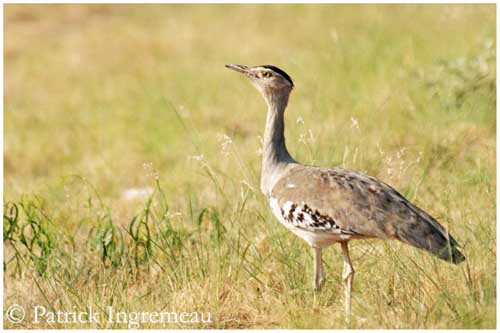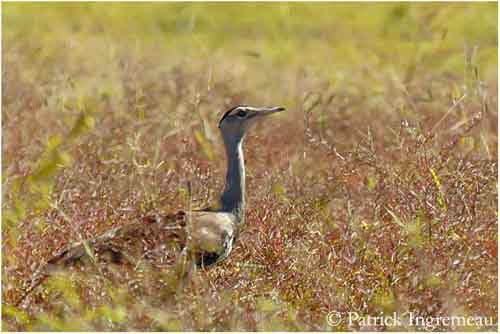
Australian Bustard
Ardeotis australis
Otidiformes Order – Otididae Family
BIOMETRICS :
Length: 80-120 cm
Wingspan: 230 cm
Weight: M : 5-10 kg – F : 2-3 kg
DESCRIPTION:
Australian Bustard is a very large bird of Australian open plains. It is also named “Bush Turkey” by Aboriginal people.
Adult has dull brown upperparts, finely streaked with buff. Upper wings coverts show mottled black and white bend. Short tail is brown.
Breast and belly are whitish, with black breast band.
Neck and head are white. Neck is finely vermiculated. On the head, we can see black forehead and crown, black eye line joining the crown behind the eyes, and white eyebrow.
Whitish or pale brown bill is pointed. Eyes are very pale, almost white. Legs and feet are yellowish to grey. Feet have three toes forwards, but no back toe.
Both sexes are similar. Female is smaller and duller than male, she has narrow brown crown and thinner breast band.
Chicks have streaked black and white down.
Juvenile is similar to adult, with less black. Young male reaches sexual maturity at 5 to 6 years, and females at about 2 to 3 years old.
FLIGHT:
Australian Bustard is the heaviest flying bird in Australia. It prefers to walk, but it is very spectacular to see this bird in flight.
REPRODUCTION:
This species produces only one clutch per year, from October to December.
Nest is situated on bare grounds or among grasses, with a good surrounding view to possible predators.
Female lays one olive-green egg. Incubation lasts about 23 days by female. She sits low, and it is well camouflaged by its plumage.
Chick is fed and cared only by female. Male doesn’t take part to nesting duties.
DIET:
Australian Bustard feeds on various kinds of food, such as seeds, fruits, vegetation, invertebrates and small vertebrates, such as grasshoppers, small reptiles and mice.
PROTECTION / THREATS / STATUS:
Australian Bustard is in decline, due to several factors such as predation by foxes and cats, fires, illegal hunting, human disturbances, habitat loss or changes by clearing and agriculture, use of pesticides and alteration to grasslands by overgrazing that reduces ground cover.
This species is listed as ‘Endangered” in New South Wales. But these birds remain relatively common in most parts of northern Australia.
Australian Bustard is an important food source for Aboriginal people in Central Australia, and it is still eaten today.
Fr: Outarde d’Australie
All : Wammentrappe
Esp : Avutarda Australiana
Ital : Otarda australiana
Nd : Australische Trap
Photographs by Patrick Ingremeau
TAMANDUA
Text by Nicole Bouglouan
Sources:
HANDBOOK OF THE BIRDS OF THE WORLD Volume 3 by Josep del Hoyo-Andrew Elliott-Jordi Sargatal - Lynx Edicions - ISBN : 8487334202
Wikipedia (Wikipedia, The Free Encyclopedia)
Birds in backyards (Birds Australia and Australian Museum)
BirdLife International (BirdLife International)

VOICE:
Australian Bustard is mostly silent, but if it is threatened or alarmed, it utters harsh barking sounds. During courtship displays, males roar or boom lowly. These sounds are produced with closed bill.
HABITAT:
Australian Bustard lives in wooded areas, open grassy plains, brushy steppes and low shrubby areas.
RANGE:
Australian Bustard lives in northern and central Australia, and southern New Guinea.
BEHAVIOUR:
Australian Bustard feeds on the ground in the morning and late afternoon. It walks looking for food. It grabs items with its short bill, and swallows it whole.
Flocks may congregate at bushfires, feeding on killed animals. When there is abundance of food, such as mice or grasshopper swarms, Australian Bustard gorges itself on this food supply. They are omnivorous.
Australian Bustard is nomadic when searching for food. In some areas in their range, they disperse and perform regular seasonal movements over long distances, in relation to wet and dry season in the North.
During breeding season, as other bustards, males gather in “display arenas” which are visited by females for mating. Males are well spaced from one another (100 to 1000m apart), and they display in order to attract females.
Male’s displays include inflating the large throat sac which fluffs long throat feathers as a fan. This display produces a deep roaring sound, coming from the air contained in this poach. Then, male struts around with cooked tail and wings downwards. Head is tossed on back while male is calling. It copulates with all females attracted to its arena. Larger males have more elaborate displays and are most successful in mating game.
Australian Bustard roosts on ground, or among vegetation and tall grasses.
